Frequency distribution facts for kids
A frequency distribution is a way to organize and show how often different values or categories appear in a set of data. Imagine you collect information from a group of people or things. A frequency distribution helps you see how many times each answer or measurement shows up.
For example, if 100 students rate how much they agree with a statement on a scale from 1 (strongly agree) to 5 (strongly disagree), a frequency distribution would list each rating (1, 2, 3, 4, 5) and tell you how many students chose each one.


Here’s what that might look like:
| Rating | How much they agree | Number of students |
|---|---|---|
| 1 | Strongly agree | 25 |
| 2 | Agree somewhat | 35 |
| 3 | Not sure | 20 |
| 4 | Disagree somewhat | 15 |
| 5 | Strongly disagree | 5 |
Sometimes, the values can be continuous, like heights or weights. In these cases, it's hard to list every single height. Instead, we group the values into ranges.
For example, if you measure the heights of students in a class, you might group them like this:
| Height range | Number of students | Total students so far |
|---|---|---|
| 4.5–5.0 feet | 25 | 25 |
| 5.0–5.5 feet | 35 | 60 |
| 5.5–6.0 feet | 20 | 80 |
| 6.0–6.5 feet | 20 | 100 |
This way, even with many different heights, the data becomes much easier to understand.
Why Frequency Distributions Are Useful
Frequency distributions make it much simpler to work with large amounts of data. Instead of looking at every single piece of information, you can quickly see patterns.
- They help you find the most common values.
- They show you how spread out the data is.
- They make it easier to compare different sets of data.
For example, if you want to know the average height of students, or the middle height, these tables help you calculate those numbers much faster.
Understanding Data Patterns
Frequency distributions help us see important features of data.
- Average: You can easily find the average (mean) or the median (the middle value) from a frequency distribution.
- Spread: They also show how spread out the data is. This is called statistical dispersion. For example, are all students about the same height, or is there a big range?
- Shape: The way a frequency distribution looks can tell you a lot. If most values are on one side, it's called skewed. If the data forms a tall peak, it has high kurtosis.
Cracking Codes
Frequency distributions are also used in cryptanalysis. This is the art of cracking secret codes. By looking at how often certain letters appear in a coded message, codebreakers can figure out what language the message is in. They can even start to guess which letters in the code stand for which letters in the real message. This is because every language has a typical frequency distribution for its letters.
See also
 In Spanish: Frecuencia estadística para niños
In Spanish: Frecuencia estadística para niños

